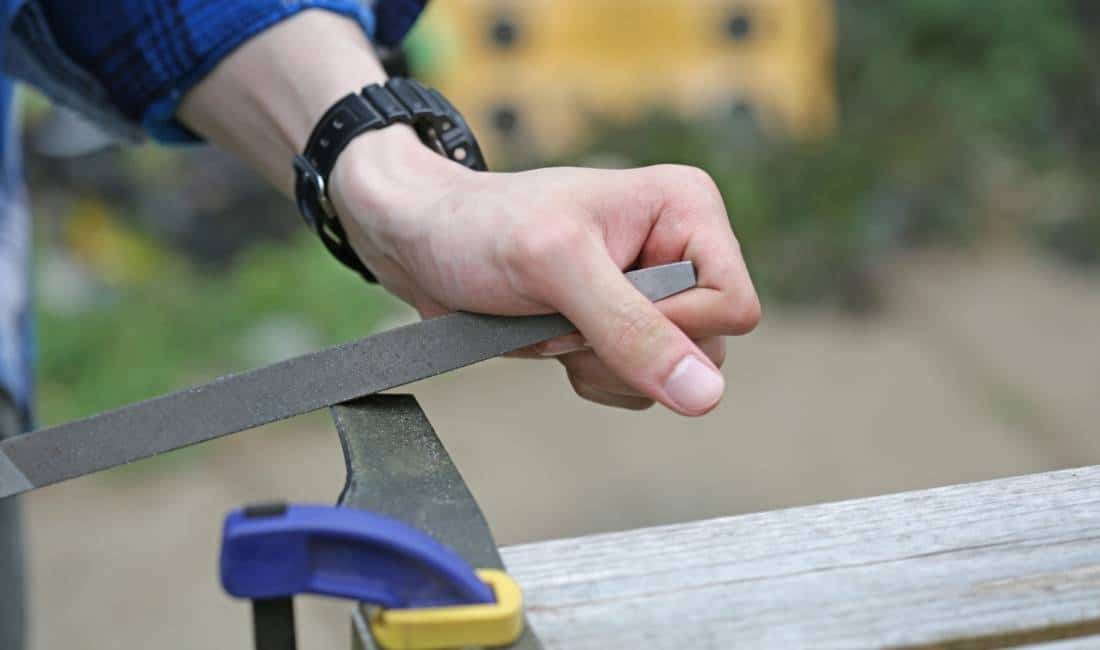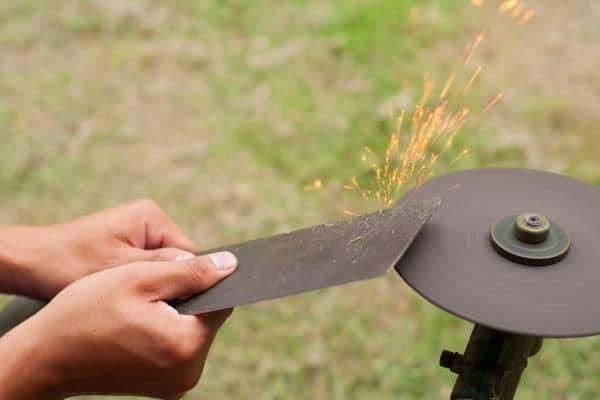Always use Sharp Blades. A sharp mower blade cuts faster and causes less damage to the grass in your yard. It’ll create clean cuts, whereas Dull blades will roughly rip through grass, leaving raggedly torn tips about the ends of the individual grass blades. Which can cause the grass to turn brown and leave your lawn more at risk of disease and pests.
WHY IT’S SO IMPORTANT TO SHARPEN YOUR LAWN MOWER BLADES
One may thank blade spinning at over 180 mph or more fast wouldn’t got to be terribly sharp to cut grass. It can be right. However, a pleasant sharp blade will slice into grass and permit it to grow during a healthier manner.
Why does this matter? Because “shredded” grass will quickly turn brown and leave your lawn looking ragged and burnt for not cutting in time.
For professionals, and other people who—quite frankly—just sort of a nice lawn, having sharp mower blades truly matters for an expert look. This goes triple for species like Fescue which grow more or less straight out of the bottom and need frequent cutting. We know a good number of professionals who sharpen their zero-turn mower blades every other day to do the job done well.
How to Identify a Mower Blade Needs Sharpening
A trained eye can tell when a blade must be sharpened just by watching the lawn after it’s been cut. If the peak of the grass is uneven (because the mower has did not cut in some areas) or if there are tears within the blades, it’s because the blade is dull. But it’ll be easier for the typical homeowner just to recollect to sharpen the mower blade every other month approximately. This works bent sharpening 3 times annually for the standard homeowner within the North.
How often should I sharpen mower blades?
Each year, before the beginning of the mowing season, sharpen the blade of your lawnmower. And if you often scalp the bottom or hit rocks, you’ll got to sharpen it again midway through the season. Manufacturers recommend sharpening the blade after every 10 hours of use, but you’ll got to roll in the hay more often if you’re running over debris like branches and pinecones.
Different Ways to Sharpen a lawn mower Blade
There are few different ways to sharpen lawnmower blades, including employing a bench grinder, hand file, rotary tool, or angle grinder. But here’s a quicker, easier and more accurate method: use a drill and sharpening stone that’s specifically designed for putting a leading edge back onto dull mower blades.
The following instructions explain the way to remove the blade before sharpening. But, depending on the design or purpose of your lawn mower, you might be capable to sharpen the blade without removing it, which can save a substantial amount of your time. Yet, I prefer taking the blade off, which allows me greater access to the cutting edges and allows to better visual inspection of any damage to the blade, like stress shatters or excessive friction.
10 Steps to Sharpen Mower Blades
- Remove the spark plug
Pull the spark plug wire from the sparking plug to prevent the motor from accidentally starting. Tape or tie it back so it doesn’t flop back to contact with the plug.
Pro Tip: We recommend always removing the sparking plug when you’re performing on the blade. If the piston happens to be at the highest of the compression stroke, a bit bump to the blade might force the piston over the “hump” and into the facility stroke. If that happens, the blade will lurch around and will break your hand!
- Tip the mower on its side
Turn the mower onto its side with the air cleaner and carburettor side up. This keeps oil and gas from dripping into the air cleaner.
The carburettor is typically easy to acknowledge because it’s throttle cables running thereto. If you retain this side up once you tip your mower over to urge at the blade, you will not get a smoke cloud from leaking oil subsequent time you begin it. Some mowers have gas caps with air holes that would leak a touch gas onto your garage floor, so work outside or keep a rag handy to wash up drips.
- Mark Your Blade
Mark your blade with paint before you remove it so you recognize which thanks to reinstall it.
Note: Mower repair pros say that the most important mistake homeowners make is installing a blade the wrong way up after sharpening it. The blade won’t cut—and they’ll go nuts trying to work out why!
Pro Tip: Keep a second blade available. the shop will probably be closed once you need one!
- Remove the Blade
Wedge a brief 2×4 between the blade and therefore the deck to clamp the blade.
Loosen or relax the bolt (or nut) with a long-handled wrench. Turn counter clockwise to get rid of the bolt and blade.
Note: You’ll usually find one bolt or nut holding the blade on. it’s always very tight and you will have got to clamp the blade to loosen it. The 2×4 method we show is straightforward, quick and safe. Don’t use your foot!
Once the blade is off, set the mower back onto all four wheels until you’re able to reinstall your blade.
- With the blade removed, take a moment and scrape clean the underside of the mowing deck with a narrow-blade Remove all caked-on grass, leaves, mud and other debris. Also, clean each side of the lawnmower blade by first spraying with penetrating oil, then scrubbing with a stiff-bristle brush.
- Lawnmower blades typically have a leading edge on each end, which are positioned on opposite sides of the blade. Each leading edge is merely about 3 or 4 inches long; it doesn’t extend the length of the blade. Clamp the blade during a vice at an angle with one among its cutting edges facing up.
- Sharpen the Blade With a drill-powered blade sharpener
Next, you’ll use a drill-powered blade sharpener. It consists of a round scratchy stone, flat sharpening guide, and ¼-inch-diameter steel bar. The stone features a bevelled surface that grinds the perfect angle onto the blade.
Chuck the sharpening stone into a drill. Placed on some safety glasses. Squeeze the trigger to run or start the drill at full suing. Slip the spinning sharpener over the sting of the blade. make certain the dull leading edge faces the bevelled side of the stone, and therefore the flat surface of the guide is against the rear of the blade. Slowly move the stone back and forth along the leading edge using moderate pressure.
Check the sharpness of the blade after four or five back-and-forth strokes. If necessary, repeat until all nicks and chips are ground off and therefore the blade is sharp. Remove the blade from the vise and rotate it to sharpen the other leading edge.
- Check for the right sharpening Angle
- File in the direction of the initialcutting angle.
- Always sharpen from the highest side of the cutting edge; this may offer youthe longest-lasting edge on the blade.
Tips: You’ll feel it bite into the steel on the blade on the push stroke as the file cuts in one direction only. If you do not feel that cutting action, your file is perhaps dull or you are not pressing down hard enough.
Don’t attempt to make your blade razor sharp; it’ll dull more quickly. “Butter-knife” sharp will do.
Note: Sharpening mulching blades is usually harder. Mulching blades may have longer or curved cutting edges, and you’ll need several sorts of files to sharpen them.
Check Blade Balance
Once both cutting edges are sharpened, there’s another important step: balance the blade. Sharpening can occasionally remove more metal from one end of the blade than the opposite,leading to an unbalanced blade. Mowing with a blade that’s out of balance will cause excessive wobbling, which may damage the motor and put undue stress on the mower.
One way to work out if a lawnmower blade is correctly balanced is to easily slip the blade’s center hole over a nail protruding from a wall. Hold the blade within the horizontal position and abandoning. If it remains level, then it’s balanced. However, if either end rotates down toward vertical, the blade is out of balance; sharpen the heavier end to get rid of some metal then retest it.
While the nail-in-the-wall technique does work, for more precise results, try to use a mower blade balancer, a multi-tiered, cone-shaped metal fixture.
Place the balancer on a flat or balanced surface, then set the blade on top; the pointed, stepped designed accepts blades with various diameter center holes. If the balance is balanced, it’ll remain level. If not, it’ll list to at least one side or the opposite , indicating which end is heavy and wishes additional sharpening.
- Reinstall the Blade
- Reinstall the blade and screw within the
- Wedge the 2×4 back in and tighten the bolt firmly together with your socket and breaker bar.
Pro Tip: Pull-out the 2×4 within the reverse direction so you’ll bear down on the breaker bar to make tighten the bolt. Mower sharpening pros say that the second commonest mistake they see is under-tightening the bolt. A loose blade throws off the engine timing and sometimes makes the mower hard to start out .
Here is a video guide on how to sharpen mower blades.
https://www.youtube.com/watch?v=zCEhaE2vln4
Other Methods: To Sharpen Lawnmower Blades
We don’t typically recommend the utilization of a file when sharpening your lawnmower blades. the method is slow and manual, and therefore the results won’t get you a nicer lawn or an extended blade life. Instead, pick one among the grinder methods above and obtain to figure. If, however, you enjoy employing a hand file—by all means, go for it.
If you happen to sharpen mower blades regularly—enough to warrant a faster process—several commercial models do exist to save lots of you time.
This pneumatic tool drives a die grinder with both a mirror and a camera interface that allows you to sharpen the blades on zero-turn mowers without removing them. It takes some finesse and skill to use, so it’s not for everybody. You furthermore may have got to watch that you simply don’t sharpen one side quite another otherwise you risk unbalancing the blades.
Some More Concerns
No matter which method you select to sharpen a lawnmower blade, please take care to wear proper personal protective equipment (PPE) to guard your eyes, hands, and ears. Grinding mower blades takes little effort and that we find it an excellent entry-level task almost anyone can handle. Still, taking proper safety precautions guards against accidents.
Let us know what you think that within the comments below. Does one have a preferred method for sharpening lawnmower blades? Which method works most consistently in your experience? We’d like to hear from you.



